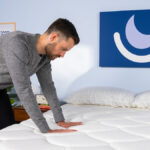While not a replacement for a sleep study, certain features in the Apple Watch may be able to highlight signs of sleep apnea to discuss with your doctor.
The Apple Watch uses motion sensors to analyze when a person is in light sleep, deep sleep, or awake. This wearable device can also monitor heart rate and blood oxygen levels during the night. As sleep apnea is characterized by periods of stopped or shallow breathing, the disorder directly affects both sleep quality and blood oxygen levels.
We’ll take a closer look at what sleep apnea is, how the Apple Watch works, and how it compares to at-home and lab-based sleep studies.
What Is Sleep Apnea?
Sleep apnea is a condition in which a person frequently stops breathing or experiences periods of very shallow breathing during sleep.
In obstructive sleep apnea (OSA), the upper airway becomes narrowed or blocked, often because of relaxed muscles and tissues in the throat. With central sleep apnea, the brain fails to properly regulate signals for breathing. Both types of sleep apnea cause fragmented sleep and can contribute to other health problems.
Are Any Apple Watches FDA-Approved to Detect Sleep Apnea?
The Food and Drug Administration hasn’t approved any iteration of the Apple Watch for detecting or diagnosing sleep apnea. The Apple Watch does have 510(k) FDA clearance for notifications related to atrial fibrillation, a heart condition sometimes connected with sleep apnea.
Obtaining FDA approval is a long and onerous process. Apple has only recently started exploring comprehensive sleep metrics, and the company does not claim that the Apple Watch is meant to diagnose sleep apnea.
Is the Sleep Data Collected by an Apple Watch Meant for Medical Use?
Apple’s respiratory rate and blood oxygen measurements are not meant for medical use. Because it is used without medical supervision and doesn’t directly measure airflow or brain waves, the Apple Watch is less accurate than a full sleep study.
How Does an Apple Watch Track Your Sleep?
The Apple Watch measures sleep using three principal sensors: a heart rate sensor, a sensor to measure blood oxygen levels, and an accelerometer that tracks motion to understand breathing and body movements. Based on these measurements, an algorithm calculates your respiratory rate, total sleep time, and how long you spend in each sleep stage.
- Awake: The Apple Watch sensors are designed to track the amount of time you spend in each sleep stage, as well as awakenings during the night. While it’s normal to spend brief intervals awake at night, multiple awakenings may be a sign of a disorder such as sleep apnea.
- Core: Confusingly, Apple refers to stage 1 and stage 2 sleep as “core sleep,” a term sometimes associated with deeper sleep during the first three sleep cycles of the night. Apple uses this term to describe the lighter sleep stages you enter when you first fall asleep, marked by a gradual slowdown in heart rate, breathing, brain activity, and body movements.
- Deep: Stage 3 sleep, known as deep sleep or slow-wave sleep, is when your brain and body do most of their repair work. During deep sleep your brain waves, breathing, and heart rate are at their slowest.
- REM: Typically associated with dreaming, rapid eye movement sleep is important for creativity and memory processing. REM sleep is characterized by faster brain activity and heart rate. Most muscles are paralyzed to stop you from carrying out movements from your dreams.
People usually cycle through light sleep, deep sleep, and REM sleep, completing several full cycles during the night. Sleep apnea can alter the sleep cycle by causing more frequent changes between stages.
How Does an Apple Watch Measure Respiration and Blood Oxygen Level?
Motion sensors in the Apple Watch calculate the number of breaths per minute, or respiratory rate, based on the sleeper’s movements. Newer Apple Watch models also have a blood oxygen monitor, which uses pulse oximetry to estimate the percentage of oxygen present in the bloodstream.
The Apple Watch only takes occasional measurements of blood oxygen levels throughout the night, and only when your arm is in the correct position. However, frequent dips in blood oxygen levels or low respiration rates could be a sign of sleep apnea.
What Should I Do if My Apple Watch’s Data Suggests I Could Have Sleep Apnea?
If you suspect you have sleep apnea based on data from your Apple Watch, talk to your doctor. They can evaluate your symptoms and refer you to a sleep clinic for further testing if needed.
Wearable devices are not always accurate at detecting health conditions. If you believe you have sleep apnea but your Apple Watch hasn’t flagged any symptoms, you should still seek the opinion of a health care professional.
Snoring? An At-Home Sleep Test May Be the Answer
Save 54% on your Sleep Test Today
Simple and convenient
- Equipment delivered to your doorstep
- One overnight test in the comfort of your own bed
Uncover sleep apnea
- Quietly collects data while you sleep
- 98% effective in detecting sleep apnea
Affordable & ships fast
- In-lab sleep tests cost ~$3,000+ (this one’s $189), HSA/FSA eligible
- Arrives in 2-4 business days
How to Get Tested for Sleep Apnea
The gold standard for diagnosing sleep apnea is in-lab polysomnography, a comprehensive sleep study that measures brain waves, sleep stages, respiration, oxygen saturation, and other metrics. In addition to obstructive sleep apnea, polysomnography can provide data to accurately diagnose other sleep disorders.
Another testing option is an at-home sleep study. While these tests vary in the number of sleep metrics they track, they are generally less comprehensive and less accurate than lab-based studies. However, they offer greater convenience and may be a good option for people who aren’t suspected of having a more complicated sleep-related breathing disorder.
At-Home Sleep Tests | Lab-Based Sleep Studies |
|---|---|
Benefits:
| Benefits:
|
Drawbacks:
| Drawbacks:
|
Frequently Asked Questions
Signs of sleep apnea that may appear on Apple Watch data include a fluctuating respiratory rate, occasional drops in blood oxygen levels, frequent changes to sleep stages, and a higher proportion of light sleep or awake periods.
An Apple Watch is not intended to be used as a medical device, and you shouldn’t rely on this device to monitor your sleep apnea treatment.
The sleep data provided by an Apple Watch may offer useful insights into how your sleep evolves over time. However, the best way to analyze your sleep apnea treatment is by paying attention to your symptoms and meeting regularly with your doctor.
There are many apps designed to detect obstructive sleep apnea, though they vary in quality and reliability. While some apps are fairly accurate, they should not be used in place of professional health care.
Some apps can be paired with the Apple Watch. For example, the Cardiogram app uses heart rate data from the Apple Watch to detect breathing anomalies. If the app detects signs of sleep apnea, it refers the user for further testing with a health care professional.
A few apps have 510(k) clearance from the FDA for pre-screening adults with suspected moderate to severe OSA, under prescription from a doctor. Examples include Drowzle and SleepCheck, which record and analyze breathing and snoring sounds.
Ask the Sleep Doctor
Have questions about sleep? Submit them here! We use your questions to help us decide topics for articles, videos, and newsletters. We try to answer as many questions as possible. You can also send us an email. Please note, we cannot provide specific medical advice, and always recommend you contact your doctor for any medical matters.

